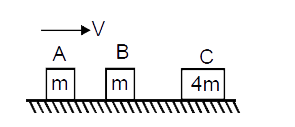A block of mass 4 m travelling at a velocity v1 in x-direction on a frictionless horizontal plane makes a head-on collision with another block of mass 2 m travelling in opposite direction with a velocity v2 . After collision, both the blocks travel as a single block along x-direction with a final velocity 5v2 . The ratio of velocities i v1v2 is Solution in Telugu
2
3
5
8
The correct Answer is:D

Momentum before collision
P1=4mv1=2mv2
Momentum after collision
P2=6m(−5v2)=−30mv2
conservation of momentum gives
P1=P2
⇒4mv1−2mv2=−30mv2 ⇒4v1=−32v2
⇒v1v2=−324=−8 or ∣∣∣v1v2∣∣∣=8
Topper's Solved these Questions
Similar Questions
Assertion (A) The number 0.00764 has three significant figures.
Reason (R ) If the number is less than 1, the zeros on the right of the decimal point but to the left of the first non-zero digit are not significant.04:30View SolutionThe moment of inertia of a solid cylinder of mass M, length 2 R and radius about R an axis passing through the centre of mass and perpendicular to the axis of the cylinder is I and about an axis passing through one end of the cylinder and perpendicular to the axis of cylinder is I2,then
05:02View SolutionA block of mas m moving at a velocity υ collides head on with another block of mass 2m at rest. If the coefficient of restitution is 1/2, find the velocities of te blocks after the collision.
07:04View SolutionA block of mass 5 kg moves from left to right with a velocity of 2ms^(-1) and collides with another block of mass 3 kg moving along the same line in the opposite direction with velocity 4 ms^(-1) . (i) If the collision is perfectly elastic, determine velocities of both the blocks after their collision. (ii) If coefficient of restitution is 0.6, determine velocities of both the blocks after their collision.
04:20View SolutionA body of mass 2 kg, travelling at 4 m/s makes a head-on collision with a body of mass 1 kg travelling in the opposite direction with a velocity of 2 m/s, the velocities of the two bodies after collision are
02:33View SolutionThree blocks are initially placed as shown in the figure. Block A has mass m and initial velocity v to the right. Block B with mass m and block C with mass 4 m are both initially at rest. Neglect friction. All collisions are elastic. The final velocity of block A is
 06:23View Solution
06:23View Solution2m द्रव्यमान वाला एक गुटका जो अचर वेग 3→v से चल रहा है, एक अन्य गुटके से जिसका द्रव्यमान m है और जो विराम में है, से टकराता है | टक्कर के फलस्वरूप दोनों गुटके आपस में जुड़ जाते हैं | टक्कर के बाद जुड़े हुए गुटकों का वेग होगा
02:13View SolutionDerive final velocities V_1 and V_2 after perfectly elastic collision.
03:44View SolutionTwo blocks of masses 10 kg and 4 kg are connected by a negligible mass and placed on a frictionless horizontal surface. An impulse gives a velocity of 14 m/s to the heavier block in the direction of the lighter block. The velocity of the centre of mass is :
04:02View SolutionA bullet of mass m and velocity v1 is fired into a large block of wood of mass M. The final velocity of the system is
04:03View SolutionA block of mass m moving at a velocity υ collides head on with another block of mass 2m at rest. If the coefficient of restitution is 1/2, find the velocities of the blocks after the collision.
04:03View SolutionA body of mass 6kg travelling with a velocity 10 m/s collides head - on and elastically with a body of mass 4kg travelling at a speed 5 m/s in opposite direction. The velocity of the second body after the collision is
06:02View SolutionA body of mass 6kg travelling with a velocity 10 m/s collides head - on and elastically with a body of mass 4kg travelling at a speed 5 m/s in opposite direction. The velocity of the second body after the collision is
06:43View SolutionA body of mass 2 kg travels with a velocity of 8 m/s makes a head on collision with another body having mass 4 kg, which is travelling in the same direction with a velocity of 1 m/s. Calculate the velocities of the two bodies after collision. Find the loss in kinetic energy of the system. (Given e = 0.5)
View SolutionA block of mass 5 kg moves from left to right with a velocity of 2ms^(-1) and collides with another block of mass 3 kg moving along the same line in the opposite direction with velocity 4 ms^(-1) . (i) If the collision is perfectly elastic, determine velocities of both the blocks after their collision. (ii) If coefficient of restitution is 0.6, determine velocities of both the blocks after their collision.
06:52View Solution

